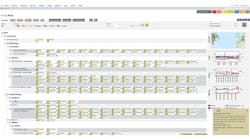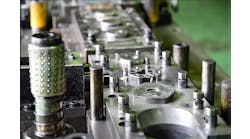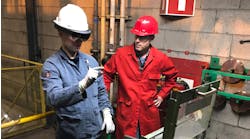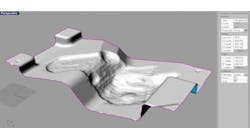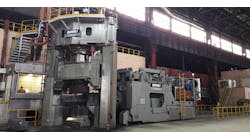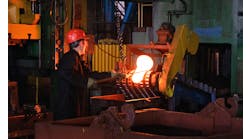The Perryman Company is a forging operation – at least in part – and like all forgers its production processes start with a blank form, in this case a bar of titanium. But there is a long story to be told about the route that bar takes to the forging press, and that’s why Perryman’s success is closely tied to its enterprise software.
Perryman became a forging operation only recently, 2012 in fact. Its story goes back to 1988, however, and the establishment of a titanium melting (EB and VAR furnaces) and ingot breakdown mill in California, PA. In 1997, Perryman expanding with hot rolling capabilities in Houston, PA, starting a series of expansions and modernization, improving melting and adding more rolling capacity and capabilities, resulting in an integrated manufacturer of titanium mill products — centerless ground bars, shapes, finished coils, and fine wire products.
The decision to become a forging operation was based on the logical extension of its titanium products into a new downstream market — medical implants — and the opportunity to acquire an Accellent Inc. cold forging operation adjacent to Perryman’s Houston manufacturing complex.
That logic remains clear, but incorporating the new assets into the manufacturing organization was a big task – and in some respects it remains a challenge. One advantage was that Perryman had been operating the Axis ERP platform offered by Aptean since its earliest days in production.
Axis ERP is an advanced program with specific functionality for metal producing and processing operations of different sizes and product varieties. Its various modules allow metal producers to develop, quote, and manufacture new products according to customers’ specification, monitor production cost and time, manage complex models necessitated by multiple product categories, scale production planning in relation to low or high volumes, and optimize high-cost equipment for maximum productivity.
Dick Thornburg, the ERP manager at Perryman, recalled the initial incorporation of the forging operations. “We’d been using Axis ERP since 1988,” he said recently, noting that Perryman’s founders had been familiar with the program from prior manufacturing experience, and adopted it for their new enterprise. The Accellent operation operated on an Oracle platform, and there was some consideration to continuing that application, but Thornburg noted that familiarity with Axis ERP once again seemed to offer the more sensible strategy. He had just six weeks to transfer the forging operation to a new platform.
Bringing Clarity to the Process
With a chuckle, he noted the complexity of the Perryman enterprise and the need to bring some clarity to the flow of material and information. “There are seven different operations that make up the Perryman Co.,” he noted, “but the philosophy is that if we can find a niche and create something that adds to the organization, we will do it.”
Synopsizing the flow, Thornburg started by noting the melting operation in California, PA. “We buy the titanium ore, and then we produce ingots. That material is rolled into a 9x9 in. bloom, and then that’s rolled into a 4x4 in. billet.
“Then, the 4x4 billet is shipped to our Houston, PA, plant, where we roll shapes and all different sizes of round bars in coil,” he continued. “And then, we take that down to the dimensions that the forging process requires, and that is shipped to the forging operation.”
He paused to interject that some of the 4x4-in. bar material is further rolled down to narrower dimensions, for aerospace (e.g., fasteners) and medical applications (e.g., surgical thread.) “That rolled material is converted to all different sizes,” he explained. “Our biggest customers for those products are aerospace manufacturers that produce rivets – the sort of products that hold the aircraft’s skin to the airframe.”
He continued, describing Perryman’s fine wire operations and shapes capabilities, the latter resulting in critical forms for aircraft OEM.
“Aircraft builders are using more Ti because it’s so light. And the more plastics they use, then the more fasteners they need, which means more titanium.
And they are using titanium in every possible application,” he observed, “so for us that means fine wire, shapes, and our two largest production (and sales) segments are coiled rod for fasteners.” Materials rolled to a smaller diameter range, e.g. 0.250 - 0.190 in., are mainly used for airplane fasteners.
In addition, Perryman’s bar division produces rounds in random lengths, with diameters from 4 in. down to 0.190 in.
Now, there is a forging operation within this maze of production. The CNC-guided cold-forging machines receive a round blank, cutting and forming it in a single step, and producing high volumes of titanium forms for knee, hip, shoulder, and spinal implants.
Even More Plastic
Just to clarify how the process is even more complex, each titanium forging produced is matched by an even greater number of equally sized and shaped plastic implant forms.
“What happens,” as Dick Thornburg explained it, “is that a doctor takes a guess of the size of an implant that a patient will need, and places the plastic blank in the joint to see if it fits. If it doesn’t, he’ll take it out and throw it away, trying another plastic blank until he finds the exact fit. Then, he'll take the titanium version of that dimension and implant it in the patient.
“So, we actually sell more of the plastic parts because the doctors have to make some guesses before they find the one that fits,” Thornburg noted. “And then they will reorder the plastic blanks and final titanium forgings to replace the ones they used.”
Plainly, this is a production process that is more end-market-focused than most forging operations, and one that demands a sophisticated ERP. For example, each knee (left and right) has a product family of up to 50 different implant sizes.
“There are about 12,000 different items/SKUs that we can make,” according to Thornburg, “covering knee, hip, shoulder, and spinal implants.” Note, too, that everything is made to order, and the only jobs that are initiated involve incoming orders. The forging plant aims to produce and deliver parts with 6- to 8-week lead times for order completion.
Migrating the forging operation from the former platform to Axis ERP was surprisingly simple, he recalled. “It was a good fit. There were lots of easy matches (for product categories and process designations.) A lot of information moved easily for us. It went smoother than we expected.
Today, Perryman’s forging operation is using virtually all of the available Axis ERP modules. “We use Quoting and Order Entry to quote work to the customer,” Thornburg began, “and once the customer agrees we enter a Sales Order. We also use MRP (manufacturing resource planning, another Aptean platform) in the forging facility, for planning and scheduling work flows, to know when we’re full and to define lead times, and for raw material purchases.”
“We use all of the material tracking functions for creating work orders, and shop-floor packets, production reporting, and labor entry.” All of the Axis ERP Shipping modules are in use too, for various necessary invoicing and billing functions.
Surprisingly High Volume QC
Thornburg said the ERP’s Quality Control modules maybe underutilized now, which he finds surprising because of the high volume of manual quality testing that must be completed on Perryman’s product line.
Closing “a gap” between basic quality certification standards available from the Axis ERP and completing the detailed quality certifications require by individual medical and aerospace customers is the ongoing challenge.
“For example, we may get a call for a certain spec, but that spec inherits 30 other specs, because the processes just keep rolling up,” Thornburg explained. “So, Axis will allow us to enter a spec, but we don’t enter all the ‘children’ specs. When it comes time to certify the order, we ought to be able to see all the specs that are met, but that’s not the case for these additional aerospace and medical industry specs, and so we have to manually enter them into the order.”
He expressed some confidence that the gap can be closed, but said that it continues to require more effort than anyone wants in order validate that the raw material and the finished material meet all the specific requirements of particular customers.
Perryman Co.’s task is even greater — to incorporate forging as a valuable feature of a more complex manufacturing organization, and to keep it successful on its own terms. Two years into the effort, some challenges remain, but Thornburg observed that customer satisfaction is high and progress on scheduling efficiency has been successful. There plans in consideration for new product lines, and for expanding the varieties of some current products to fulfill customers’ needs. All in all, it’s an efficient enterprise that has the resources, and a plan, for growth.

